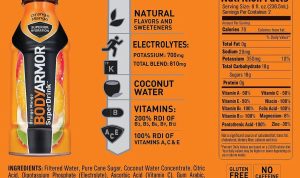Serving Size and Portion Control
Digoirno regular pizza nutrition facts – Understanding serving sizes is crucial for accurately interpreting the nutritional information provided on Digiorno pizza packaging and for managing your overall calorie intake. The nutritional facts typically listed are for a specific serving size, often a fraction of the entire pizza. Consuming more than the stated serving size significantly increases the total calories, fat, and sodium consumed.The nutritional impact of varying serving sizes can be easily visualized.
A simple bar graph would effectively illustrate this. The horizontal axis would represent different serving sizes (e.g., 1/4 pizza, 1/3 pizza, 1/2 pizza, whole pizza). The vertical axis would represent the corresponding values for calories, total fat, saturated fat, and sodium. Each serving size would have a separate bar for each nutrient, allowing for a direct comparison of how these values increase proportionally with the amount of pizza consumed.
For example, if a 1/4 pizza contains 300 calories, a 1/2 pizza would contain approximately 600 calories, assuming a consistent caloric density across the pizza. The graph would visually demonstrate the exponential increase in nutrient intake as the serving size increases.
Portion Control Strategies for Digiorno Pizza, Digoirno regular pizza nutrition facts
Portion control is essential for enjoying Digiorno pizza without compromising your dietary goals. Overconsumption of frozen pizza, due to its high calorie and sodium content, can lead to weight gain and contribute to various health issues. Practicing mindful eating and implementing strategies for portion control can help mitigate these risks.
Creative Meal Planning with Frozen Pizza
Incorporating frozen pizza into a balanced diet requires careful planning. Instead of viewing it as a complete meal, consider it one component of a larger, healthier meal plan. For example, a 1/4 of a Digiorno pizza could be paired with a large salad brimming with vegetables and a light vinaigrette. This combination provides a balanced meal with both satisfying pizza and added nutritional value from the salad.
Another strategy is to cut the pizza into smaller slices before serving, making it easier to control portion sizes. Freezing individual slices after cooking also allows for portioned servings later, eliminating the temptation of consuming more than planned. Planning ahead and pre-portioning are effective ways to ensure that your frozen pizza intake remains within your daily calorie and nutrient goals.
FAQ Overview: Digoirno Regular Pizza Nutrition Facts
What is the sodium content of a Digiorno regular pizza?
The sodium content varies depending on the flavor and serving size, but generally, it’s high. Check the nutrition label on the specific pizza box for the exact amount.
Are there any gluten-free options available in the Digiorno regular pizza range?
No, Digiorno regular pizzas are not currently offered in gluten-free varieties. Check their website or packaging for updated information.
How does the nutritional content compare to other brands of frozen pizza?
Nutritional content varies significantly between brands. Comparing labels from different brands allows for a direct comparison of calories, fat, sodium, and other nutrients.
Can I bake Digiorno pizza from frozen?
Yes, baking from frozen is the recommended cooking method for most Digiorno pizzas for optimal taste and texture. Always follow the instructions on the packaging.
Are there any vegetarian options within the Digiorno regular pizza range?
Several Digiorno regular pizza flavors are vegetarian, but always check the ingredient list to confirm the absence of meat products.
Digiorno regular pizza, while convenient, is often high in calories and sodium. For a healthier alternative, consider adding vegetables to your meals; you might be surprised by the nutritional benefits, such as those found in yellow squash nutrition facts , which are significantly lower in calories and fat. Returning to the Digiorno pizza, understanding its nutritional profile helps make informed choices about portion control and frequency of consumption.






